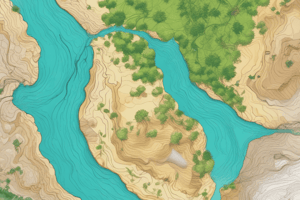Podcast
Questions and Answers
What is the primary task of rivers?
What is the primary task of rivers?
- Flood prevention only
- Collecting materials and moving them downstream (correct)
- Providing drinking water
- Sports and recreation
The thalweg is the slowest flow within a river channel.
The thalweg is the slowest flow within a river channel.
False (B)
What is the term for streamside vegetation that protects banks and reduces run-off?
What is the term for streamside vegetation that protects banks and reduces run-off?
Riparian areas
The bottom surface of a river channel is referred to as the ______.
The bottom surface of a river channel is referred to as the ______.
Match the following terms with their definitions:
Match the following terms with their definitions:
Which factor does NOT affect the balance between sediment load and stream flow?
Which factor does NOT affect the balance between sediment load and stream flow?
Medium flows are defined as those that occur infrequently but do not significantly change the channel.
Medium flows are defined as those that occur infrequently but do not significantly change the channel.
What energy source powers rivers in their work to shape landscapes?
What energy source powers rivers in their work to shape landscapes?
Rivers' channels change constantly under ______ conditions.
Rivers' channels change constantly under ______ conditions.
What happens during major floods in rivers?
What happens during major floods in rivers?
Flashcards are hidden until you start studying
Study Notes
Stream Morphology
- Channel: The watercourse.
- Bankfull channel: Indicated by high-water marks, represents Q2 water flow.
- Stream bed: The bottom surface.
- Substrate: The composition of the stream bed.
- Channel banks: The sloping sides of the channel.
- Thalweg: The fastest, deepest part of the flow, representing the deepest part of the channel
- Sediment: Sand, silt, clay, gravels, cobbles, and boulders moved by the river.
- Vegetation: Includes Large Woody Debris (LWD).
- Riparian area: Streamside vegetation which protects banks and reduces runoff.
What Do Rivers Do?
- Primary task: Landscape change.
- Rivers collect and move materials downstream.
- Gravity: Energy source for river processes.
- Water: The force that moves sediment.
- Rocks and vegetation: Resistance to the flow of water.
- Creates habitat, manages flood waters, and mitigates drought.
River Channels are Dynamic
- Channels are constantly changing under natural conditions.
- High flows: infrequent major floods that move large amounts of sediment and alter the channel.
- Medium flows: Average high flows, including bankfull flow (Q2). Most of the work of shaping rivers occurs over longer time periods.
- Low flows: Frequent but minimally influence the channel and floodplain.
Balance Between Sediment Load and Stream Flow
- Balance between the load and size of sediment and the slope and stream flow of a river system.
- Climate, geology, topography, vegetation, and land use affect this balance.
- Influences depositing and degrading processes.
Lane’s Balance
- Stream processes are in a dynamic balance.
- Adding water: An increase in water can move sediment and alter the channel.
- Debris enters the stream: Landside debris can impact sediment transport and change the channel.
- Steepening the slope: Steepening the slope can increase the velocity of the water and lead to erosion.
- Base level: As a river moves toward base level (the lowest point it can erode), the slope becomes less steep and the river may deposit sediment.
Studying That Suits You
Use AI to generate personalized quizzes and flashcards to suit your learning preferences.




